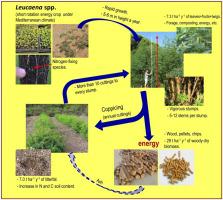Industrial Crops and Products ( IF 5.9 ) Pub Date : 2020-09-15 , DOI: 10.1016/j.indcrop.2020.112911 M. Fernández , J. Alaejos , E. Andivia , P. Madejón , M.J. Díaz , R. Tapias

|
The use of woody nitrogen-fixing plant species as multipurpose and energy crops aims to enhance biomass yield while improving soil properties. Yet, the effectiveness of this option is still under debate especially the use of short rotation cropping in water and nutrient limited environments. This study investigated whether short rotation coppicing of four taxa of multipurpose biomass woody legume Leucaena spp. can improve soil conditions when grown for biomass under a Mediterranean environment. Biomass yield, mineral composition and heat value of the biomass and the mineral and organic matter content of soil were evaluated. Under favorable growing conditions, woody dry biomass production was up to 29 Mg ha−1 year−1 with slight but significant differences between the four taxa that were tested. After 11 years of cropping, the soil showed higher fertility and microbial activity compared to the uncropped plot. Leucaena cultivation increased soil nitrogen by 35 %, dehydrogenase activity by 98 %, and organic matter and carbon content (by 41 %). Annual cuttings resulted in the highest biomass production, followed by two and three year cuttings. The mineral composition and the calorific capacity of woody biomass make it suitable for commercial use as an energy source (generating on average 151 MW h ha-1 year-1). In conclusion, short rotation coppicing of nitrogen-fixing woody species results in high biomass production rates with the restoration of degraded soils, constituting a sustainable agroforestry system for rural areas.
中文翻译:

豆科树木Leucaena spp的短轮伐期。在地中海环境中提高土壤肥力的同时提高生物量产量
使用木质固氮植物作为多功能作物和能源作物,旨在提高生物量,同时改善土壤特性。然而,该方案的有效性仍在争论中,尤其是在水和养分有限的环境中使用短轮作。本研究调查了短时轮转是否应对了多用途生物质木本植物豆科植物白叶锦鸡儿属的四个分类群。在地中海环境下种植生物质能改善土壤条件。评价了生物量的产量,矿物组成和生物量的热值以及土壤中矿物质和有机质的含量。在有利的生长条件下,木质干燥生物量的产量高达29 Mg ha - 1 年-1在测试的四个分类单元之间存在细微但显着的差异。种植11年后,与未种植的土地相比,土壤表现出更高的肥力和微生物活性。银合欢种植使土壤氮增加35%,脱氢酶活性增加98%,有机质和碳含量增加41%。每年的砍伐导致最高的生物质产量,其次是两年和三年的砍伐。木质生物质的矿物成分和热容量使其适合商业用作能源(平均151 MW h ha -1 year -1)。总之,固氮木本植物的短期轮作能够提高生物量的生产率,并能恢复退化的土壤,从而构成了农村地区可持续的农林业系统。



























 京公网安备 11010802027423号
京公网安备 11010802027423号